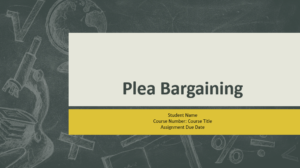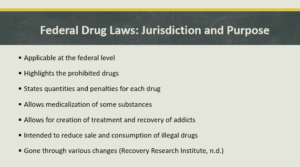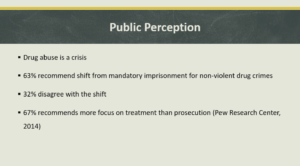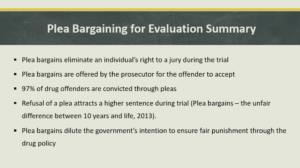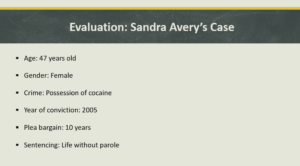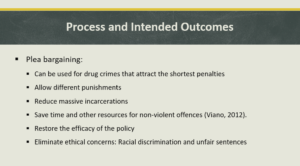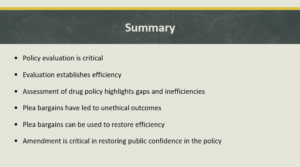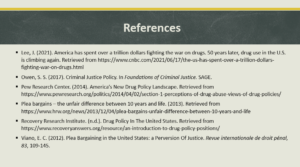Applying a Plea Bargain to a Criminal Justice Policy
Hello and welcome to today’s presentation. We shall discuss plea bargaining and its application to the process of evaluating a criminal justice policy.
The outline highlights the main topics that will be contained in the slides. These topics will be important for assessing the Federal Drug Laws policy and determining its effectiveness.
The formulation of criminal justice policies takes place in six stages. The formulation of a policy occurs as a response to a current issue in society that affects law enforcement bodies or citizens. Thus, the first step is the identification of the problem. The debate about the issue takes place, leading to the identification of the goals, the agenda’s formation, and the policy’s adoption. The policies are then implemented. The last and most important step is evaluation, which takes place in either process or outcomes. The process evaluation looks at everything in between implementation and stops at the results, which fall under outcome evaluation. This evaluation determines if the policy effectively resolves the intended issue by looking at the impact and changes achieved or missed altogether. Through this process, the policy formulators can identify gaps that still need improvement. In a nutshell, policy evaluation justifies the commitment of resources to the same and facilitates critical decision-making around the issue (Owen, 2017).
Applicable at the federal level, the Federal Drug laws policy was formulated to deal with the menace of drug and substance abuse, which has led to deaths and imprisonment in the past. As such, the policy highlights the prohibited drugs, which include marijuana, fentanyl, hashish, heroin, LSD, cocaine, and Flunitrazepam. The policy also states the different penalties for various measurements of the drug. This policy elicits a wide range of opinions in the country. Besides the prohibition of various substances, the policy allows the medicalization of some of these drugs. It is also intended to reduce the sale and consumption of drugs. However, the consistent demand creates a black market in the case of prohibition. The drug policy has gone through different changes over the decades as stakeholders highlight the need to view it from a health issue perspective more than just a criminal (Recovery Research Institute, n.d.).
The drug policy was created for prohibition, decriminalization, medicalization, and legalization purposes. However, each of these aspects has multiple advantages and challenges. Prohibition makes substances less accessible to users. On the other hand, it creates a fertile ground for black markets. As a result, crimes around drugs increase as the rates of incarceration from these go higher. Decriminalization of drugs allows individuals to possess small amounts of the substance for personal use. Their discovery attracts small fines and does not result in criminal penalties. This move reduces the negative effects that arise from prohibition. However, the cartels continue to exist and peddle the drugs around (Recovery Research Institute, n.d.).
Medicalization of drugs such as marijuana is important for its medicinal use. Through increased regulation of psychoactive drugs by health professionals, lives are saved, and pain is managed. This also facilitates the de-stigmatization of using drugs such as marijuana. On the flip side, such drugs are found to have negative effects on human bodily functions. Examples include the effects of psychoactive drugs on the uterus during pregnancy. More resources are therefore required to conduct extensive tests for safety during consumption. Legalization occurs in multiple forms, including without commercialization, with limits, and with full commercialization. Once drugs are legalized, recreational users can access the substances easily. It also results in job creation as manufacturing, processing, and distribution increase. The government can gain tax revenue from the industry players. Unfortunately, the increase in sales and consumption of these drugs becomes inevitable upon legalization, which poses a health and safety issue to society (Recovery Research Institute, n.d.).
According to the Pew Research Center, a study conducted to weigh the public’s perception of drug abuse established that most individuals believe it is a national crisis. In terms of policies, the study sought to understand the public’s perception regarding the penalties for various drug offenses and the focus of the government’s resources. At least 63% recommended that the government should shift towards less mandatory imprisonment for drug crimes that do not involve violence. However, 32% disputed this recommendation. Similarly, most respondents suggested that the government should focus more resources on treating drug abusers than prosecuting them. This suggestion highlights that drug abuse is a health issue more than a criminality issue for most users. Clearly, the public appeared unsatisfied with the government’s management of drug-related crimes (Pew Research Center, 2014).
The war on drugs has consumed significant financial resources both at the federal and state levels. By 2020, the federal government had allocated at least $34.6 billion to this war and $41 billion by 2022. The state governments found a significant chunk of their resources directed towards correctional facilities, where incarceration due to drug offenses had increased. At least 1 in every 5 prisoners is incarcerated due to drug offenses. Every year, the US government spends at least $182 billion on correctional facilities at the federal level. For states, privatization of correctional facilities has been viewed as a solution to the increasing incarceration and related costs. In addition, drug offenders tend to go through racial bias, where more blacks and Latinos are prosecuted than other racial groups in the country. The usage of drugs has also increased significantly. Deaths related to drug overdose have increased from 70,630 in 2019 to 90,000 in 2020 (Lee, 2021). These rates confirm that more people are indulging in drug abuse. Consequently, the country’s economic and health burden has increased as a result of the drug policy, rendering it unsuccessful.
The policy was intended to reduce the usage of prohibited drugs and the health problems that arise from the same. It seems to have achieved the complete opposite as more individuals use the drugs. This is evident in the increased number of deaths due to drug overdose between 2019 and 2020. the increased imprisonment is a signal that law enforcers are encountering more drug offenders. This has led to higher budget allocations because correctional facilities must be maintained. In addition, more people of color are being imprisoned for drug offenses than their counterparts (Lee, 2021). Furthermore, the main issue with the policy is the focus on prosecution rather than treatment and mandatory imprisonment. This makes it impossible to reduce the number of drug offenders in prisons even when violence was not part of the offense. The policy’s inability to direct stakeholders toward rehabilitating the users may have contributed to the increasing overdose-related deaths.
A plea bargain is offered to save time and money and the anguish and stress of going through a trial by jury. Today, at least 97% of drug offenders are convicted through plea bargains. Failure to accept the bargains could attract a higher sentence. While plea bargains reduce the time and resources that go into a trial for all parties, they dilute the policy’s objective. The policy’s objective was to ensure that drug offenders receive fair punishment for their offenses. However, the sentences that result from a trial compared to those offered through a plea bargain are incongruent (Plea bargains – the unfair difference between 10 years and life, 2013).
Sandra Avery from Florida was convicted to life without parole for dealing a small amount of cocaine after turning down a 10-year plea bargain. The conviction will see Sandra Avery spend all her life behind bars for a drug-related crime that did not include violence. This case highlights the unfair nature of the American justice system and the war on drugs initiative. Failure to accept the plea bargain, which would have had Sandra incarcerated for 10 years, led to a life sentence. The connection between the two sentences is lacking and appears unfounded. The question begs; was Sandra given a life sentence as punishment for failing to accept the plea bargain? While one may cite that she had 3 previous drug offenses (cocaine worth $100 for personal use), this does not justify the sentence. It explains why most individuals (97%) prefer to accept plea bargains, leading to massive incarcerations. Sandra had served in the army after reforming from drug abuse (Plea bargains – the unfair difference between 10 years and life, 2013). This is one of the cases showing the extent to which prosecutors use plea bargains to convict drug offenders in the name of the war on drugs.
Plea bargaining can be used to restore the policy’s efficiency. As already established, the policy has increased the economic and health burden through massive incarceration and drug usage, leading to health issues. Plea bargaining can be effective in ensuring that resources are used efficiently. Individuals with drug offenses that do not include violence or for personal use can be placed under rehabilitation with the objective of reducing their dependency. At the same time, they can be required to serve house imprisonment, thus reducing the massive incarceration (Viano, 2012). Plea bargaining can also be applied to minor, multiple cases from individuals to deter frequent use and trade. However, all these can only occur if the government acknowledges that the war on drugs should be directed towards health issues more than criminality issues. It should also amend the policy to eliminate minimum imprisonment penalties and allow for other kinds of punishment that allow rehabilitation in case of violation. Such amendments should confirm the policy’s ethical stand by eliminating unethical aspects such as racial discrimination and unfair sentences.
As established within the presentation, evaluating criminal justice policies is important because it highlights the impact, gaps, resulting changes, and efficiencies. The drug policy appears to be ineffective in delivering its intended mandate. The increased economic and health burden on the country does not resonate with the reduction of drug abuse. As the public asserted, embracing drug abuse as a health issue is more important than a crime element. The use of plea bargains in drug offense cases shows unethical elements that law enforcers and the justice system propagate. Once the policy is amended to eliminate minimum imprisonment and introduce different punishments, it is possible to have a renewed perspective and possibly achieve the intended objective.
Lee, J. (2021). America has spent over a trillion dollars fighting the war on drugs. 50 years later, drug use in the U.S. is climbing again. Retrieved from https://www.cnbc.com/2021/06/17/the-us-has-spent-over-a-trillion-dollars-fighting-war-on-drugs.html
Owen, S. S. (2017). Criminal Justice Policy. In Foundations of Criminal Justice. SAGE.
Pew Research Center. (2014). America’s New Drug Policy Landscape. Retrieved from https://www.pewresearch.org/politics/2014/04/02/section-1-perceptions-of-drug-abuse-views-of-drug-policies/
Plea bargains – the unfair difference between 10 years and life. (2013). Retrieved from https://www.hrw.org/news/2013/12/04/plea-bargains-unfair-difference-between-10-years-and-life
Recovery Research Institute. (n.d.). Drug Policy In The United States. Retrieved from https://www.recoveryanswers.org/resource/an-introduction-to-drug-policy-positions/
Viano, E. C. (2012). Plea Bargaining in the United States: a Perversion Of Justice. Revue internationale de droit pénal, 83, 109-145.
ORDER A PLAGIARISM-FREE PAPER HERE
We’ll write everything from scratch
Question
Create a 12-slide presentation in which you explain how Plea bargaining can be applied to evaluating a criminal justice policy. This presentation will be included in a workshop for new hires who will be evaluating criminal justice policies and programs.
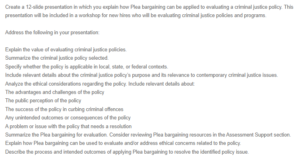
Applying a Plea Bargain to a Criminal Justice Policy
Address the following in your presentation:
Explain the value of evaluating criminal justice policies.
Summarize the criminal justice policy selected.
Specify whether the policy is applicable in local, state, or federal contexts.
Include relevant details about the criminal justice policy’s purpose and its relevance to contemporary criminal justice issues.
Analyze the ethical considerations regarding the policy. Include relevant details about:
The advantages and challenges of the policy
The public perception of the policy
The success of the policy in curbing criminal offenses
Any unintended outcomes or consequences of the policy
A problem or issue with the policy that needs a resolution
Summarize the Plea bargaining for evaluation. Consider reviewing Plea bargaining resources in the Assessment Support section.
Explain how Plea bargaining can be used to evaluate and/or address ethical concerns related to the policy.
Describe the process and intended outcomes of applying Plea bargaining to resolve the identified policy issue.

